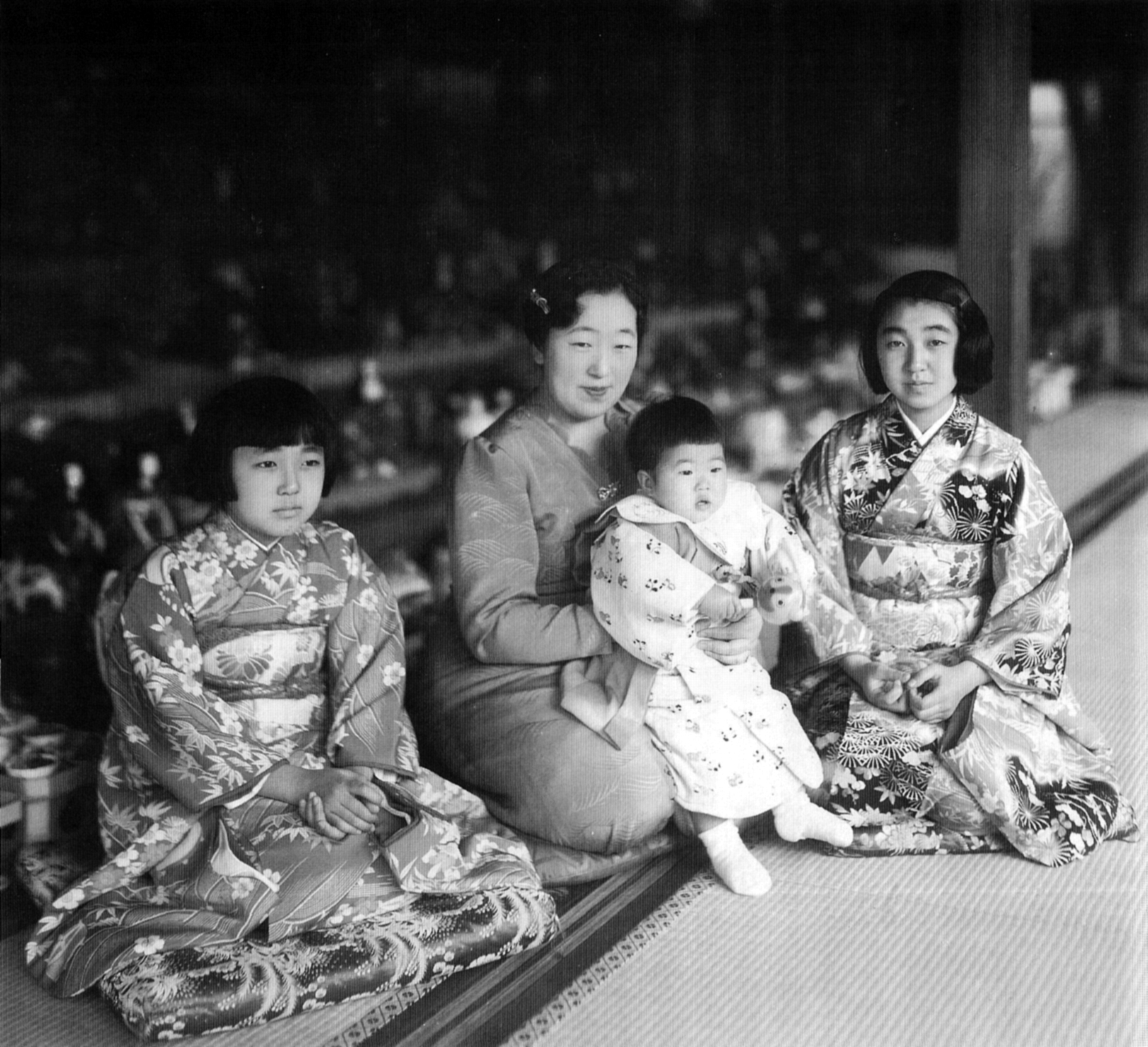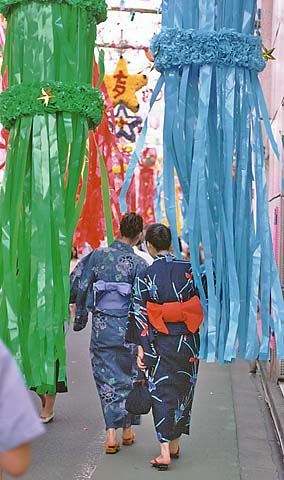|
Gosekku
The ''Gosekku'' (五節句), also known as ''sekku'' (節句), are the five annual ceremonies that were traditionally held at the Japanese imperial court. The origins were Japanese practices merged with Chinese practices and celebrated in Japan since the Nara period in the 8th century CE. The Japanese culture and tradition incorporated this in a unique way that spread throughout the country. The festivals were held until the beginning of the Meiji era. Some of them are still celebrated by the public today. *''Kochōhai'': on New Year's, the nobles processed before the emperor during the ''Jinjitsu'' celebrations. *''Kyokusui'': on the third day of the third lunar month, courtiers floated rice wine down a stream in the palace garden. Each guest would take a sip and then write a poem. The ''Hinamatsuri'' festival continues today. *''Ayame no hi'': on the fifth day of the fifth month, mugwort was hung to dispel evil spirits. Celebrated as the Japanese iris (ayame) festival at cour ... [...More Info...] [...Related Items...] OR: [Wikipedia] [Google] [Baidu] |
Jinjitsu
''Jinjitsu'' (, "Human Day") is one of the five seasonal festivals ( ''gosekku'') that were integrated into the Japanese Imperial calendar over 1,000 years ago. ''Sekku'' is the term given meaning special day of observance. The festival is now celebrated on the seventh day of the first month and is considered a part of the New Year observances that are celebrated during this time. It is also known as Nanakusa-no-sekku, the "Feast of Seven Herbs", from the custom of eating seven-herb kayu ( ') to ensure good health and to ward off away evil spirits in the coming new year. The name "Day of Mankind" generates from the stipulation of no harm coming to humans on this day and the name "Festival of The Seven Herbs" comes from a tradition of store owners gathering and providing the seven lucky herbs to the emperor as nanakusagayu. The typical herbs used for the creation of nanakusagayu are nazuna, seri, gogyo, hotokenza, suzushiro, and hakobe. However, in some regions other variat ... [...More Info...] [...Related Items...] OR: [Wikipedia] [Google] [Baidu] |
Hinamatsuri
, also called Doll's Day or Girls' Day, is a religious (Shinto) holiday in Japan, celebrated on 3March of each year. Nussbaum, Louis-Frédéric (2005)"Hina Matsuri"in ''Japan Encyclopedia'', p. 313. Platforms covered with a red carpet–material are used to display a set of representing the Emperor, Empress, attendants, and musicians in traditional court dress of the Heian period. Customs is one of the that are held on auspicious dates of the Chinese calendar: the first day of the first month, the third day of the third month, and so on. After the adoption of the Gregorian calendar, these were fixed on 1January, 3March, 5May, 7July, and 9September. The festival was traditionally known as the , as peach trees typically began to flower around this time. Although this is no longer true since the shift to Gregorian dates, the name remains and peaches are still symbolic of the festival. The primary aspect of is the display of seated male and female dolls (the and ), wh ... [...More Info...] [...Related Items...] OR: [Wikipedia] [Google] [Baidu] |
Ikeda Koson
was a Japanese painter. He moved to Edo and studied painting with Sakai Hōitsu (1761-1828). He created a series of paintings that are closely related to a set by Hoitsu depicting court festivals (''gosekku''), that were adapted from Chinese practices and celebrated in Japan since the Nara period The of the history of Japan covers the years from CE 710 to 794. Empress Genmei established the capital of Heijō-kyō (present-day Nara). Except for a five-year period (740–745), when the capital was briefly moved again, it remained the cap .... References 1801 births 1866 deaths 19th-century Japanese painters {{japan-painter-stub ... [...More Info...] [...Related Items...] OR: [Wikipedia] [Google] [Baidu] |
:Category:Japanese Words And Phrases ...
{{Commons Words and phrases by language Words Words Words A word is a basic element of language that carries an objective or practical meaning, can be used on its own, and is uninterruptible. Despite the fact that language speakers often have an intuitive grasp of what a word is, there is no consen ... [...More Info...] [...Related Items...] OR: [Wikipedia] [Google] [Baidu] |
Nara Period
The of the history of Japan covers the years from CE 710 to 794. Empress Genmei established the capital of Heijō-kyō (present-day Nara). Except for a five-year period (740–745), when the capital was briefly moved again, it remained the capital of Japanese civilization until Emperor Kanmu established a new capital, Nagaoka-kyō, in 784, before moving to Heian-kyō, modern Kyoto, a decade later in 794. Japanese society during this period was predominantly agricultural and centered on village life. Most of the villagers followed Shintō, a religion based on the worship of natural and ancestral spirits named ''kami.'' The capital at Nara was modeled after Chang'an, the capital city of the Tang dynasty. In many other ways, the Japanese upper classes patterned themselves after the Chinese, including adopting the Chinese writing system, Chinese fashion, and a Chinese version of Buddhism. Literature Concentrated efforts by the imperial court to record its history produced the ... [...More Info...] [...Related Items...] OR: [Wikipedia] [Google] [Baidu] |
Meiji Era
The is an era of Japanese history that extended from October 23, 1868 to July 30, 1912. The Meiji era was the first half of the Empire of Japan, when the Japanese people moved from being an isolated feudal society at risk of colonization by Western powers to the new paradigm of a modern, industrialized nation state and emergent great power, influenced by Western scientific, technological, philosophical, political, legal, and aesthetic ideas. As a result of such wholesale adoption of radically different ideas, the changes to Japan were profound, and affected its social structure, internal politics, economy, military, and foreign relations. The period corresponded to the reign of Emperor Meiji. It was preceded by the Keiō era and was succeeded by the Taishō era, upon the accession of Emperor Taishō. The rapid modernization during the Meiji era was not without its opponents, as the rapid changes to society caused many disaffected traditionalists from the former samurai cl ... [...More Info...] [...Related Items...] OR: [Wikipedia] [Google] [Baidu] |
Mugwort
Mugwort is a common name for several species of aromatic flowering plants in the genus ''Artemisia.'' In Europe, mugwort most often refers to the species '' Artemisia vulgaris'', or common mugwort. In East Asia the species '' Artemisia argyi'' is often called "Chinese mugwort" in the context of traditional Chinese medicine, or () in Mandarin. ''Artemisia princeps'' is a mugwort known in Korea as () and in Japan as (). While other species are sometimes referred to by more specific common names, they may be called simply "mugwort" in many contexts. Etymology The Anglo-Saxon ''Nine Herbs Charm'' mentions . A folk etymology, based on coincidental sounds, derives ' from the word "mug"; more certainly, it has been used in flavoring drinks at least since the early Iron Age. * Other sources say ''mugwort'' is derived from the Old Norse (meaning "marsh") and Germanic languages, German ''wuertz'' (''wort'' in English, originally meaning "root"), which refers to its use since ancient ti ... [...More Info...] [...Related Items...] OR: [Wikipedia] [Google] [Baidu] |
Japanese Iris
The term "Japanese iris" encompasses three species of Irises cultivated in gardens or growing wild in Japan: ''hanashōbu'' (''Iris ensata''), ''kakitsubata'' ('' Iris laevigata'') and ''ayame'' (''Iris sanguinea''). Of these three species, ''I. ensata'' is the one most commonly referred to as "Japanese iris" outside Japan. The bluish purple color of the flowers of the Japanese garden iris is an example of the copigmentation phenomenon. ''Hanashōbu'' The grows in the wet land and is the most extensively cultivated variety in Japanese gardens. According to the place where it was cultivated, it is classified into the Edo (Tokyo), Higo (Kumamoto Prefecture), Ise (Mie Prefecture), American (U.S.) and other series. It is extensively grown in gardens throughout the temperate zones. Several cultivars have been selected, of which 'Rose Queen' and 'Variegata' have gained the Royal Horticultural Society's Award of Garden Merit. ''Kakitsubata'' The grows in the semi-wet land and i ... [...More Info...] [...Related Items...] OR: [Wikipedia] [Google] [Baidu] |
Tango No Sekku
, also known as , is one of the five annual ceremonies that were traditionally held at the Japanese imperial court called . It is the Japanese equivalent of Double Fifth and was celebrated on the fifth day of the fifth moon in the lunar calendar or Chinese calendar. After Japan switched to the Gregorian calendar, the date was moved to May 5.Nussbaum, Louis Frédéric ''et al'' (2005). "Tango no Sekku" in Other festivals are celebrated on the same day in mainland China, Hong Kong, Macau, and Taiwan as the Duanwu Festival or Tuen Ng Festival (Cantonese), in Korea as the Dano Festival, and Vietnam as on the traditional lunar calendar date. means "beginning" and is a simplified form of , referring to the Chinese zodiac name for the fifth lunar month. Days of the week also have zodiac animals. Thus, originally meant "the first horse day of the fifth month". However, is a homonym for in Japanese, so during the Nara period the meaning shifted to become the fifth day of the fift ... [...More Info...] [...Related Items...] OR: [Wikipedia] [Google] [Baidu] |
Tanabata
, also known as the Star Festival ( 星祭り, ''Hoshimatsuri''), is a Japanese festival originating from the Chinese Qixi Festival. It celebrates the meeting of the deities Orihime and Hikoboshi (represented by the stars Vega and Altair respectively). According to legend, the Milky Way separates these lovers, and they are allowed to meet only once a year on the seventh day of the seventh lunar month of the lunisolar calendar. The date of Tanabata varies by region of the country, but the first festivities begin on 7 July of the Gregorian calendar. The celebration is held at various days between July and August. History The festival was introduced to Japan by the Empress Kōken in 755. It originated from , an alternative name for Qixi which is celebrated in China and also was adopted in the Kyoto Imperial Palace from the Heian period. The festival gained widespread popularity amongst the general public by the early Edo period, when it became mixed with various Obon or Bon t ... [...More Info...] [...Related Items...] OR: [Wikipedia] [Google] [Baidu] |
Vega
Vega is the brightest star in the northern constellation of Lyra. It has the Bayer designation α Lyrae, which is Latinised to Alpha Lyrae and abbreviated Alpha Lyr or α Lyr. This star is relatively close at only from the Sun, and one of the most luminous stars in the Sun's neighborhood. It is the fifth-brightest star in the night sky, and the second-brightest star in the northern celestial hemisphere, after Arcturus. Vega has been extensively studied by astronomers, leading it to be termed "arguably the next most important star in the sky after the Sun". Vega was the northern pole star around 12,000 BCE and will be so again around the year 13,727, when its declination will be . Vega was the first star other than the Sun to have its image and spectrum photographed. It was one of the first stars whose distance was estimated through parallax measurements. Vega has functioned as the baseline for calibrating the photometric brightness scale and was one of the st ... [...More Info...] [...Related Items...] OR: [Wikipedia] [Google] [Baidu] |
.jpg)
.jpg)





